UP Board Notes For Class 8 Science Chapter 16 Light Abstract
- All the objects or surfaces reflect light.
- When light from an object enters our eyes, we can see that object. The light may have been emitted by the object or reflected by it.
- The ray of light which strikes a surface is called the incident ray. The ray of light which comes back after reflection from the surface is known as the reflected ray.
- The point at which the incident ray strikes the surface is called the point of incidence.
- The perpendicular drawn to the reflecting surface at the point of incidence is called the normal.
- The angle between the normal and the incident ray is called the angle of incidence. It is denoted by Zi.
- The angle between the normal and the reflected ray is known as the angle of reflection. It is denoted by Zr.
- Reflection from a smooth surface such as a mirror is called regular reflection.
When the rays reflected from a surface are not parallel, the reflection is known as diffused or irregular reflection. It takes place on rough surfaces. - The splitting of white light into its constituent colors is known as the dispersion of light.
- Important parts of an eye are the cornea, iris, pupil, lens, retina, and optic nerves.
- Light enters the eye through the cornea. It helps protect the eye and focus the light.
- The amount of light entering into the eye is controlled by the iris. It is the iris that gives distinctive color to the eyes.
- The size of the pupil increases or decreases depending on the brightness of the light falling on the eye.
- The lens in our eyes forms images of the objects on a layer called the retina. The impression of an image persists on the retina for about 1/16th of a second.
- The retina contains many nerve cells. These cells are of two types: cones and rods.
- Sensory cells are not present at the junction of the optic nerve and the retina. Thus, no vision is possible at that spot. This spot is called the blind spot.
- Myopia or short-sightedness is an eye defect in which people can see near objects clearly but cannot see distant objects so clearly.
- Hypermetropia or long-sightedness is an eye defect in which people cannot see near objects
clearly but they can see distant objects quite well. - A cataract is an eye defect that occurs particularly during old age. The eyesight becomes foggy during a cataract because the eye lens becomes cloudy.
- The Braille system enables visually challenged people to read and write. This system uses patterns of raised dots to represent letters and numerals.
Read and Learn More UP Board Notes for Class 8 Science
UP Board Notes For Class 8 Science Chapter 16 Light Laws Of Reflection
We can see objects because of the light that falls on them. When the light from an object enters our eyes, we see that object. The bouncing back of light rays from the surface of an object is called the reflection of light. The two laws of reflection are:
| Class 10 Science | Class 11 Chemistry |
| Class 11 Chemistry | Transformation of Sentences |
| Class 8 Maths | Class 8 Science |
- The angle of incidence is equal to the angle of reflection.
- The incident ray, the reflected ray, and the normal drawn at the point of incidence, all lie in the same plane.
UP Board Notes For Class 8 Science Chapter 16 Light Activity 1
Aim: To verify the first law of reflection i.e. the angle of incidence is equal to the angle of reflection
Procedure:
- Fix a white sheet of paper on a drawing board or a table.
- Take a comb and close all its openings, except one in the middle. You can use a strip of black paper for this purpose.
- Hold the comb perpendicular to the sheet of paper.
- Throw light from a torch through the opening of the comb from one side. With a slight adjustment of the torch and the comb, you will see a ray of light along the paper on the other side of the comb.
- Keep the comb and the torch steady.
- Place a strip of plane mirror in the path of the light ray. Notice that after striking the mirror, the ray of light is reflected in another direction.
- Draw lines showing the position of the plane mirror, the incident ray and the reflected ray on the paper with the help of your friends.
- Remove the mirror and the comb. Draw a line making an angle of 90° to the line representing the mirror at the point where the incident ray strikes the mirror.
- Measure the angle of incidence and the angle of reflection. Repeat the activity several times by changing the angle of incidence.
- Note the observations in the observation table.
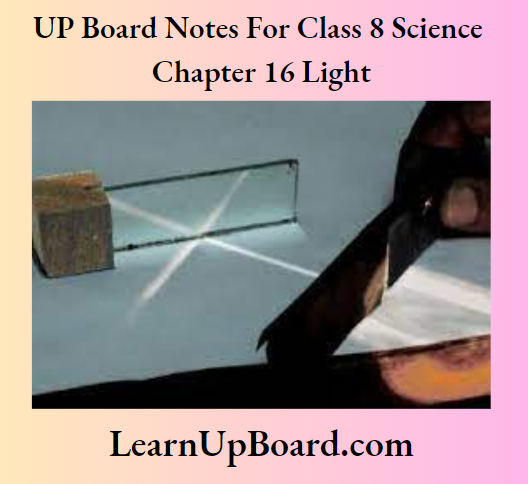
(a) Arrangement for showing reflection
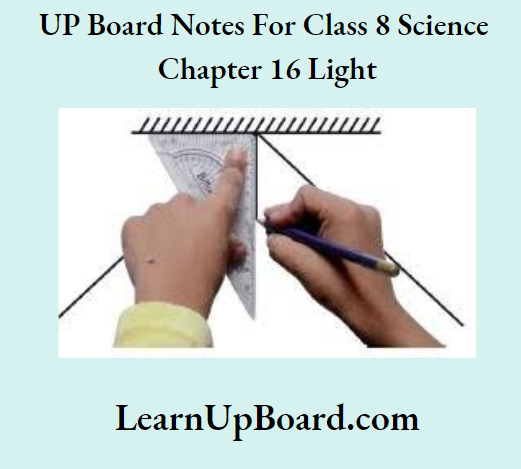
(b) Drawing the normal
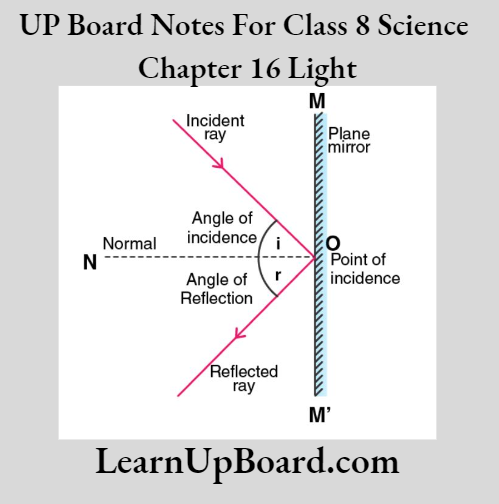
(c) Angle of incidence and the angle of reflection
Observation:
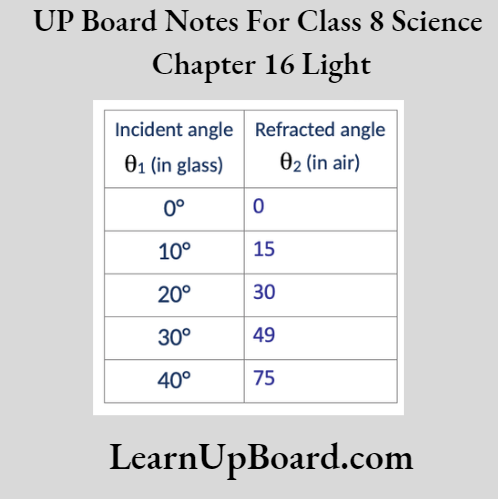
Conclusion: The angle of incidence is always equal to the angle of reflection.
UP Board Notes For Class 8 Science Chapter 16 Light Activity 2
Aim: To verify the second law of reflection, i.e. the incident ray, the normal at the point of incidence, and the reflected ray all lie in the same plane
Procedure:
- Fix a white sheet of paper on a drawing board in such a way that a small portion of it protrudes a little beyond the edge of the drawing board.
- Place the plane mirror strip on the sheet of paper and hold it vertically with a mirror stand.
- Throw a ray of light on the mirror using a torch.
- Look at the reflected ray. Make sure that the reflected ray extends to the projected portion of the paper.
- Bend that part of the projected portion on which the reflected ray falls.
- Now, bring the projected portion of the paper back to its original position and observe.
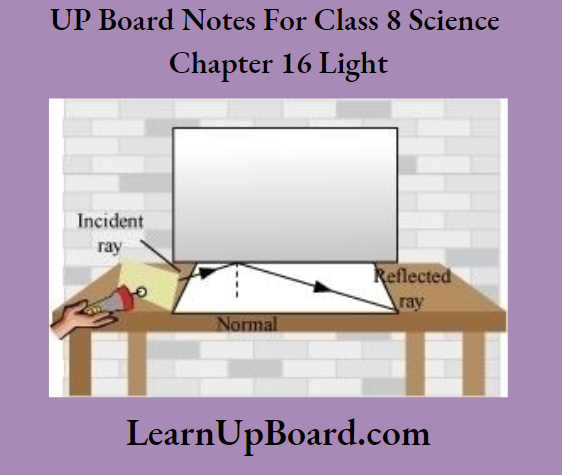
Incident ray, reflected ray, and the normal at the point of incidence lie in the same plane
Observation: When the paper is bent, the reflected ray is not seen.
The entire sheet fixed on the drawing board represents a plane. The bent paper represents a new plane in which the incident ray and the normal lie.
Conclusion: The incident ray, the normal at the point of incidence, and the reflected ray lie in the same plane.
UP Board Notes For Class 8 Science Chapter 16 Light Activity 3
Aim: To show the image formed by a plane mirror
Procedure:
- Place a source of light O in front of a plane mirror PQ such that two rays OA and OC are incident on it.
- Draw normal to the surface of the mirror PQ at points A and C.
- Now, draw the reflected rays at points A and C. Label the reflected rays as AB and CD, respectively.
- Extend them further. The reflected ray on the extension will appear to meet at point I.
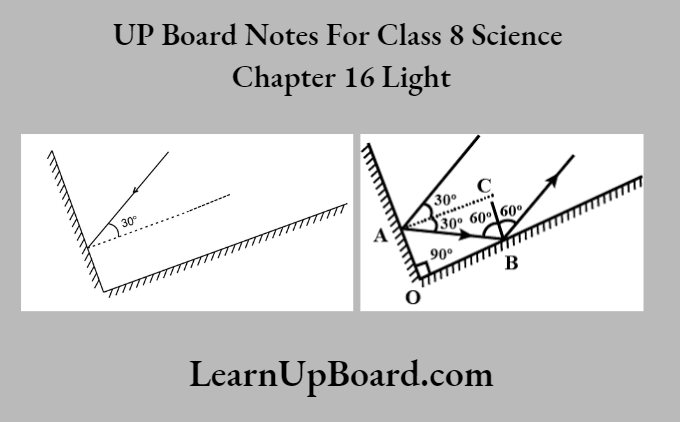
Observation: Since the reflected rays do not actually meet at I, but only appear to do so, we say that a virtual image of the point O is formed at I. Such an image cannot be obtained on a screen.
Conclusion: The image formed by a plane mirror is virtual.
UP Board Notes For Class 8 Science Chapter 16 Light Objective Type Questions
A. State whether the following statements are true or false.
- It is only when light from an object enters our eyes that we see the object.
- The angle of reflection is the angle between the normal and the reflected ray.
- The angle of incidence is always greater than the angle of reflection.
Answers:
- ITrue
- True
- False
B. Multiple Choice Questions
Question 1. If the angle of incidence is 45°, what will be the angle of reflection?
- 30°
- 45°
- 55⁰
- 90°
Answers: 2) 45°
Question 2. Which of these phenomena enables us to see objects?
- Circulation of light
- Absorption of light
- Reflection of light
- None of these
Answers: 3) Reflection of light
C. Fill in the blanks.
- The light ray, which strikes any surface, is called the_____ray.
- The angle of incidence is the angle between_______and the____ray.
Answers:
- Incident
- Normal, incident
UP Board Notes For Class 8 Science Chapter 16 Light Short Answer Type Questions
A. How do we see objects?
We see various objects due to the reflection of light. All the objects reflect light falling on them. The reflected light reaches our eyes and we can see the object.
B. State the characteristics of the image formed by a plane mirror.
The image formed by a plane mirror is always:
- virtual and erect,
- of the same size as the object, and
- laterally inverted
C. What is meant by lateral inversion?
Lateral inversion
In the image formed by a plane mirror, the left side of the object appears on the right and the right side appears on the left. This is known as lateral inversion.
Types of Reflection: Regular and Diffused
Objects which shine in the light of the other objects are called illuminated objects, for example, the Moon. Objects which emit their light are known as luminous objects, for example, the Sun.
Reflection from a smooth surface such as a mirror is called regular reflection. When the rays reflected from a surface are not parallel, the reflection is known as diffused or irregular reflection. When two mirrors are inclined to each other, they give multiple images. Beautiful patterns are formed in a kaleidoscope because of multiple reflections.
UP Board Notes For Class 8 Science Chapter 16 Light Activity 4
Aim: To show the reflection of light rays by an irregular surface
Procedure:
- Imagine that parallel rays are incident on an irregular surface as shown in the figure.
- Use the laws of reflection to construct the reflected rays at various points.
- Observe whether the reflected rays are parallel to each other or not.
(a) Parallel rays incident on an irregular surface
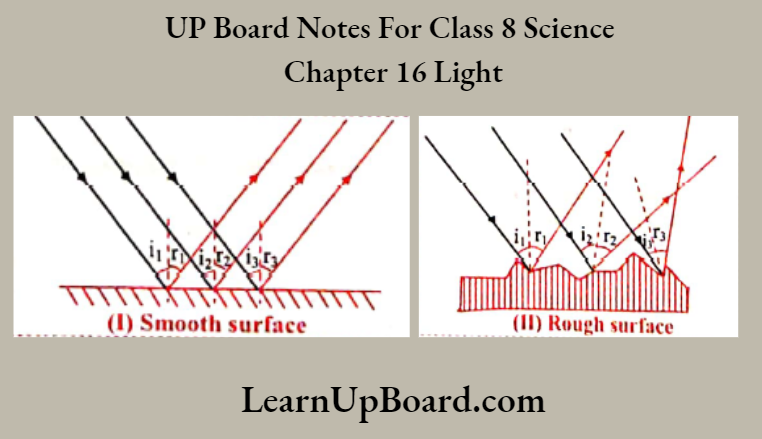
(b) Rays reflected from irregular surface
Observation: The rays are reflected in different directions.
Conclusion: When all the parallel rays reflected from a plane surface are not parallel, the reflection is known as diffused or irregular reflection. Reflection from a smooth surface such as a mirror is called a regular reflection.
UP Board Notes For Class 8 Science Chapter 16 Light Activity 5
Aim: To study the formation of multiple images
Procedure:
- 1Take two plane mirrors. Set them at right angles to each other with their edges touching and hinge them using adhesive tape.
- Place a coin in between the mirrors and notice the number of images of the coin formed.
- Now, hinge the mirrors using the adhesive tape at different angles, say 45°, 60°, 120°, 180°, etc. Place an object (say, a candle) in between them.
- Note down the number of images of the object in each case.
- Finally, set the two mirrors parallel to each other and then find out how many images of the candle placed between them are formed.
Observations:
- Three images are formed by the two mirrors placed at right angles to each other.
- The number of images varies depending on the angle of inclination between the two mirrors.
- When the two mirrors are placed parallel to each other and an object is placed between them, infinite images are formed.
Conclusion: Multiple images are formed when two or more mirrors are used in combination.
UP Board Notes For Class 8 Science Chapter 16 Light Activity 6
Aim: To make a kaleidoscope
Procedure:
- Take three rectangular mirror strips, each about 15 cm long and 4 cm wide.
- Join them together to form a prism as shown in the figure ‘a’. Fix them in a circular cardboard tube or the tube of a thick chart paper. Make sure that the tube is slightly longer than the mirror strips.
- Close one end of the tube with a cardboard disc having a hole in the center, through which you can see as shown in Figure ‘b’. To make the disc durable, paste a piece of transparent plastic sheet under the cardboard disc.
- At the other end, touching the mirrors, fix a circular plane glass plate as shown in Figure ‘c’. Place on this glass plate several small pieces of colored glass (broken pieces of colored bangles). Close this end of the tube with a ground glass plate.
- Allow enough space for the color pieces to move around.
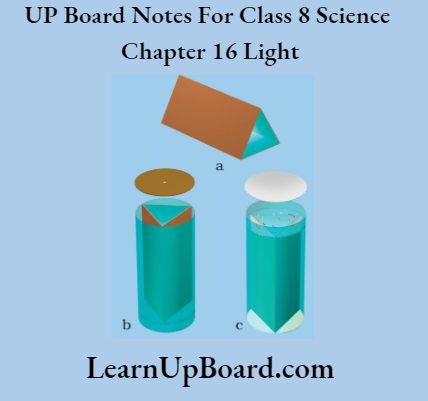
Making a kaleidoscope
Observation: When you peep through the hole of a kaleidoscope, you will be able to see a variety of patterns in the tube.
Conclusion: A kaleidoscope is based on the idea of multiple images formed by using two or more mirrors placed at certain angles to one another.
UP Board Notes For Class 8 Science Chapter 16 Light Activity 7
Aim: To show the dispersion of light
Procedure:
- Take a plane mirror of suitable size and place it in a bowl (Katori).
- Fill the bowl with water and place this arrangement near a window such that direct sunlight falls on the mirror.
- Adjust the position of the bowl such that the reflected light from the mirror falls on a wall. If the wall is not white, fix a sheet of white paper on it.
- Observe the reflected light.
Observation: The reflected light splits into its constituent colors.
Conclusion: The sunlight, also called white light, consists of seven colors. The mirror and water form a prism. This breaks up the light into its constituent colors. Such splitting of white light into its constituent colors is known as dispersion of light.
UP Board Notes For Class 8 Science Chapter 16 Light Objective Type Questions
1. State whether the following statements are true or false.
- A reflected ray of light cannot be reflected again.
- Regular reflection takes place from uneven or rough surfaces.
- When two mirrors are placed parallel to each other and an object is placed between them, an infinite number of images of the object are formed.
Answers:
- False
- False
- True
2. Fill in the blanks.
- The sunlight, also known as white light, consists of_____colours.
- Working of a kaleidoscope is based on the concept of_____
Answers:
- Seven
- Multiple reflections
UP Board Notes For Class 8 Science Chapter 16 Light Short Answer Type Questions
1. ‘Reflection from two mirrors enables you to see objects which are not visible directly. Give two examples of this.
Example 1: After a haircut, a hairdresser places a mirror at the back of the head to show the haircut.
Example 2: Periscopes are used in submarines or tanks and also by soldiers in bunkers to see the things that are outside or above the level of observation.
2. Reflection depends on the nature of the surface on which the light falls. Explain.
When parallel rays fall on a plane surface, all the reflected rays are parallel. But if the reflecting surface is irregular (uneven), all the rays reflected from the surface are not parallel. So, the reflection depends on the nature of the surface on which the light falls.
The Human Eye: Structure, Working, Defects, and Care
The important parts of the eye are the cornea, iris, pupil, lens, retina, and optic nerve.
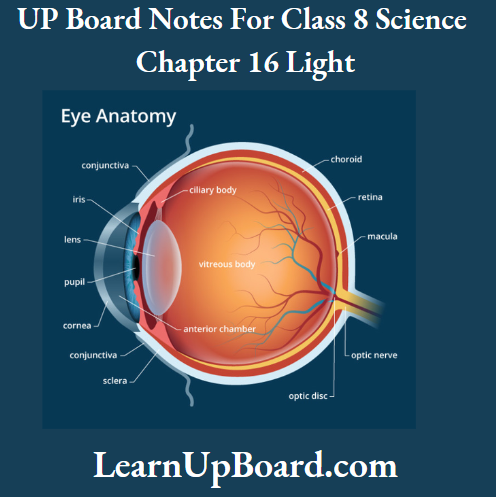
Human eye
The transparent, front part of the white outer coat of the eye is called the cornea. The dark muscular structure behind the cornea is called the iris. The small opening in the iris is called the pupil. Its size is controlled by the iris. Behind the pupil, there is a lens that is thicker in the middle. The muscles that hold the lens in place are called ciliary muscles. The lens focuses light on a layer at the back of the eye called the retina. It contains several nerve cells.
Sensations felt by the nerve cells are transmitted to the brain through the optic nerve. The nerve cells which are sensitive to the bright light are called cones. The nerve cells which are sensitive to the dim light are called rods.
UP Board Notes For Class 8 Science Chapter 16 Light Activity 8
Aim: To observe the change in the size of the pupil with a change in the amount of light falling on the pupil.
Precaution: Never use a laser torch for this activity.
Procedure:
- Look into your friend’s eye and observe the size of the pupil.
- Throw light on his/her eye with a torch and observe the pupil again.
- Switch off the torch and observe his/her pupil once again.
Observation: When the light from the torch falls on the pupil, its size becomes smaller. When the light falling on the pupil is dim, the size of the pupil gets bigger.
Conclusion: The iris controls the amount of light entering the eye by changing the size of the pupil. When the light from the torch falls on the pupil, its size becomes smaller so that less amount of light can enter into the retina. When the light is dim, its size gets bigger so that more amount of light can enter into the retina.
UP Board Notes For Class 8 Science Chapter 16 Light Activity 9
Aim: To demonstrate the presence of blind spot
Procedure:
- Make a round mark and a cross on a sheet of white paper about 6 – 8 cm apart.
- Hold the sheet of paper at arm’s length from the eye.
- Close your left eye and look continuously at the cross.
- Move the sheet slowly towards you, keeping your eye on the cross.
- Now, close your right eye look at the round mark, and repeat the activity.
Observation: The round mark or the cross disappears at some point. The disappearance of the mark shows that there is a point on the retina that cannot send messages to the brain when light falls on it.
Conclusion: The blind spot is a region on the retina that does not have any rods and cones. Hence, the images falling on this part of the retina cannot be seen.
UP Board Notes For Class 8 Science Chapter 16 Light Activity 10
Aim: To show that the impression of an image persists for about 1/16th of a second on the retina even after we stop looking at the object
Procedure:
- Take a square piece of cardboard with sides 6 – 8 cm.
- Make two holes on it as shown in the figure.
- Thread a string through the two holes.
- Draw or paste a cage on one side of the cardboard and a bird on the other side.
- Twist the string and make the card twirl rapidly.
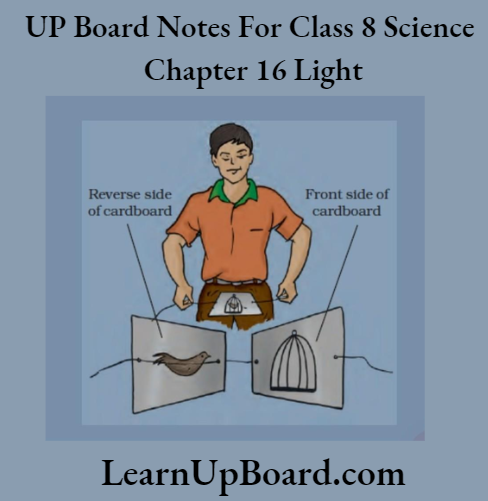
Observation: When the card twirls rapidly, the bird seems to be inside the cage.
Conclusion: When still images of a moving object are flashed at a rate faster than 1/16th of a second, the eye perceives this object as moving.
UP Board Notes For Class 8 Science Chapter 16 Light Objective Type Questions
A. State whether the following statements are true or false.
- Cones and rods are the light-sensitive cells.
- The color of the human eye is determined by the cornea.
- A normal eye can see nearby and distant objects.
Answers:
- True
- False
- True
B. Multiple Choice Questions
Question 1. Which part of the human eye controls the size of the pupil?
- Cornea
- Lens
- Retina
- IrisAnswers: 4) Iris
Question 2. Which of the following holds the lens of the eye in its place?
- Cones
- Optic muscles
- Ciliary muscles
- Rods
Answers: 2) Ciliary muscles
C. Fill in the blanks.
- Sensations felt by the nerve cells are transmitted to the brain through the_____
- Short-sightedness is also known as_____
Answers:
- Optic nerve
- Myopia
UP Board Notes For Class 8 Science Chapter 16 Light Short Answer Type Questions
A. What is cataract? Can it be corrected?
Answers:
Cataract Disease:
Cataract is a common defect of the eye wherein vision becomes foggy. It occurs particularly in old age. However, it is possible to treat this defect. The opaque lens is removed and a new artificial lens is inserted. Modern technology has made this procedure simpler and safer.
B. What is the range of normal vision of the human eye?
Answers:
The range of normal vision of the human eye
The minimum distance at which the human eye can see objects distinctly varies with age.
However, the range of vision of a normal human eye is from infinity to about 25 cm.
C. Explain how the human eye works.
Answers:
Working Of Human Eye
Light enters our eye through the cornea. The amount of light entering the eye is controlled by the iris. The lens focuses the image of the object on the retina, which converts these optical images into optical pulses. These pulses are sent to the brain through the optical nerves.
UP Board Notes For Class 8 Science Chapter 16 Light Textbook Exercises
Question 1. Suppose you are in a dark room. Can you see objects in the room? Can you see objects outside the room? Explain.
Answers: We see things only when light reflected by them enters our eyes. Since no light is reflected from the surface of the objects in a dark room, we are not able to see them. However, outside the room, where light is available, objects can reflect light and thus, we can see them.
Question 2. Differentiate between regular and diffused reflection. Does diffuse reflection mean the failure of the laws of reflection?
The key differences between regular and diffused reflection are:
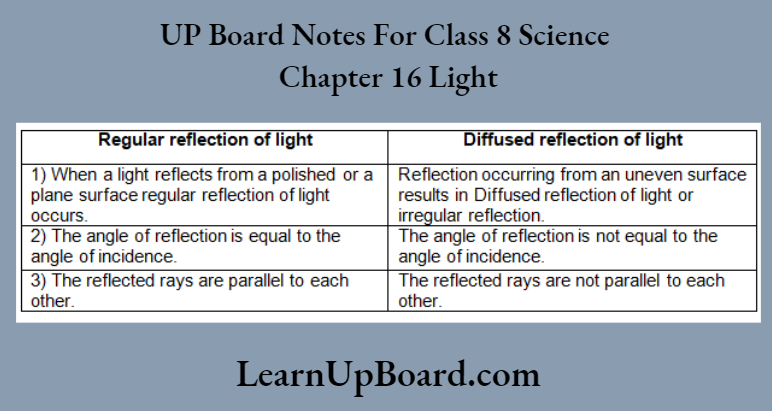
No. Diffused reflection does not mean the failure of the laws of reflection because the irregularities in the reflecting surface cause it.
Question 3. Mention against each of the following whether regular or diffused reflection will take place when a beam of light strikes. Justify your answer in each case.
- Polished wooden table
- Chalk powder
- Cardboard surface
- Marble floor with water spread over it
- Mirror
- Piece of paper
Answers:
- A polished wooden table will have regular reflection because its surface is smooth.
- A chalk powder will give a diffused reflection because the chalk powder particles are not smooth.
- The cardboard surface has minute irregularities on it, so it will have a diffused reflection.
- Marble stone with water spread over it will have regular reflection if the water is stable. However, if waves are formed, diffused reflection will take place.
- Any mirror has a shiny and smooth surface. Therefore, regular reflection will be observed.
- A piece of paper has a rough surface. Therefore, the diffused reflection will be observed.
Question 4. State the laws of reflection.
The laws of reflection are as follows:
(a) The angle of incidence is always equal to the angle of reflection.
(b) The incident ray, the normal at the point of incidence, and the reflected ray, all lie in the same plane.
Question 5. Describe an activity to show that the incident ray, the reflected ray, and the normal at the point of incidence lie in the same plane.
Procedure:
- Fix a white sheet of paper on a drawing board in such a way that a small portion of it projects a little beyond the edge of the drawing board.
- Place a plane mirror strip on the sheet of paper and hold it vertically with a mirror stand.
- Throw a ray of light on the mirror using a torch. Look at the reflected ray. Make sure that the reflected ray extends to the projected portion of the paper.
- Bend the part of the projected portion on which the reflected ray falls. Now, bring the projected portion of the paper back to its original position and observe.
Observation: The entire sheet fixed onto the drawing board represents a plane. When the paper is bent, a new plane is formed which is different from the plane in which the incident ray and the normal lie. So the reflected ray is not seen.
Conclusion: The incident ray, the normal at the point of incidence, and the reflected ray lie in the same plane.
Question 6. Fill in the blanks in the following:
- A person I’m in front of a plane mirror seems to be from his image.
- If you touch your_____ ear with the right hand in front of a plane mirror, it will be seen in the mirror that your right ear is touched with the_____ hand.
- The size of the pupil becomes______when you see in dim light
- Night birds have______ cones than rods in their eyes.
Answers:
- I
- Left, left
- Larger
- Lesser
Choose the correct option in Questions
Question 7. The angle of incidence is
- Always
- Sometimes
- Under special conditions
- Never
Answer: (1) Always
Question 8. An image formed by a plane mirror is
- (virtual, behind the mirror, and enlarged
- virtual, behind the mirror, and of the same size as the object
- real at the surface of the mirror and enlarged
- real, behind the mirror, and of the same size as the object.
Answer: (2) virtual, behind the mirror, and of the same size as the object
Question 9. Describe the construction of a kaleidoscope.
Answer:
The construction of a kaleidoscope
A kaleidoscope is made up of three narrow strips of plane mirrors inclined at 60° to each other and enclosed in a tube. A ground glass plate on its inner side closes one end of the tube. The space between the mirrors is filled with colored pieces of glass or broken bangles. Cardboard with a hole in the center is fixed on the other end of the tube through which different patterns formed by the mirrors are seen.
Question 10. Draw a labeled sketch of the human eye.
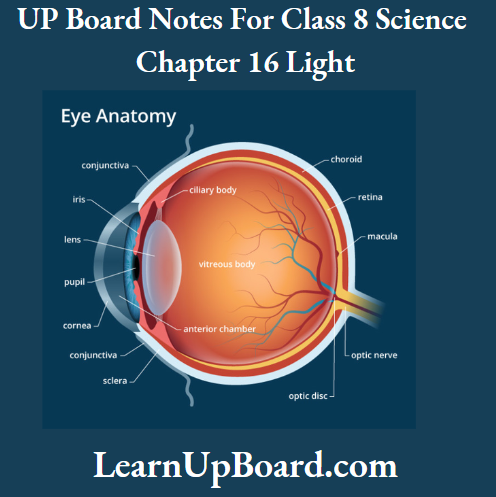
Question 11. Gurmit wanted to perform an activity to see the change in the size of the pupil by throwing light into the eyes using a laser torch. Her teacher advised her not to do so. Can you explain the basis of her teacher’s advice?
Answers: Gurmit’s teacher advised her not to do so because laser light is harmful to the eyes. It can cause permanent damage when flashed directly in the eyes.
Question 12. Explain how you can take care of your eyes.
The following precautionary measures should be taken to care for eyes:
- We should wash our eyes frequently with cold water.
- We should not rub our eyes or touch them with dirty hands. If dust particles enter our eyes, we should wash our eyes with clean water.
- We must not look at the Sun or a powerful light directly.
- We should eat a sufficient quantity of vitamin A-enriched food like raw carrots, green vegetables, papaya, mango, eggs, milk, etc.
- We should maintain a suitable distance while reading or watching TV.
- An eye specialist should be consulted in case of any irritation or redness in the eyes.
Question 13. What is the angle of incidence of a ray if the reflected ray is at an angle of 90° to the incident ray?
If Zi= angle of incidence, and Zr= angle of reflection
Then, Zi + <r = 90° (given)
But Zi = Zr (according to the laws of reflection)
:: Zi+Zi= 90°
(186
or, 22i = 90°
or, <r = Zi = 45°
Therefore, the angle of incidence of the ray will be 45°.
Question 14. How many images of a candle will be formed if it is placed between two parallel plane mirrors separated by 40 cm?
Infinite images of the candle will be formed if it is placed between two parallel plane mirrors.
Question 15. Two mirrors meet at right angles. A ray of light is incident on one at an angle of 30° as shown in the figure below. Draw the reflected ray from the second mirror.
Answer:
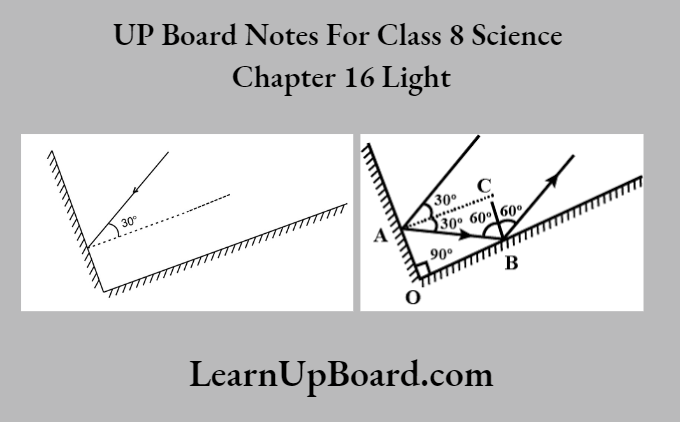
Question 16. Bhoojo stands at A just on the side of a plane mirror as shown in the figure below. Can he see himself in the mirror? Also, can he see the image of objects situated at P, Q, and R?
Answer: Bhoojo cannot see his image. However, he can see images of objects P but not Q and R.
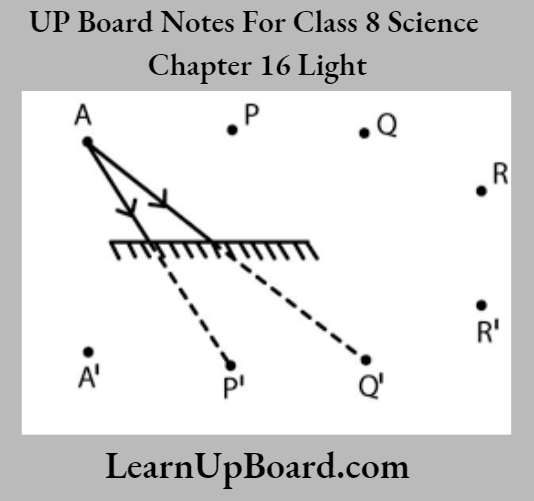
Question 17. (a) Find out the position of the image of an object situated at A in the plane mirror (Figure given below).
- (Can Paheli at B see this image?
- Can Bhoojo at C see this image?
- When Paheli moves from B to C, where does the image of A move?
Answer:
- The image of A in the mirror will be as far behind as the object in front of the mirror.
- Yes, Paheli can see the image.
- Yes, Bhoojho can see this image.
- When Paheli moves from B to C, the image of A will not move.
UP Board Notes For Class 8 Science Chapter 16 Light Hots Corner
1. If all the objects around us were to reflect light in a regular way, what possible problems might we face?
Answers: When the rays of light fall on an object with a smooth surface, they are reflected in one direction only. On the other hand, when the rays of light fall on an object with an uneven surface, they get reflected in different directions. It is due to the irregular reflection that we can see objects from every direction. Further, irregular reflection of the sunlight by the objects around us enables our room to have light during the day even if sunlight does not fall directly.
However, if all the objects around us were to reflect light regularly, we would not be able to see the objects (1) from different directions and (2) during the daytime even when light is not falling on them directly.
UP Board Notes For Class 8 Science Chapter 16 Light Objective Type Questions
1. Circle the odd one out.
- Cornea, Iris, Retina, Cataract
- Kaleidoscope, Telescope, Microscope, Binoculars
- Crow, Kite, Eagle, Owl
Answers:
- Cataract
- Kaleidoscope
- Owl
2. Give one word for the following.
- The splitting of light into its constituent colors
- The dark muscular structure behind the cornea gives the eye its distinct color
- The ray of light which returns after striking the surface
Answers:
- Dispersion
- Iris
- Reflected ray
3. State whether the following statements are true or false.
- An owl has a larger number of rods and a lesser number of cones.
- Rods are sensitive to bright light.
- A plane mirror forms an image of an object as far behind the mirror as the object in front of it.
Answers:
- True
- False
- True
4. Fill in the blanks.
- The image formed by a plane mirror is called_______image.
- In cataracts, the lens of the eye becomes______.
- There are______types of nerve cells found in the retina
Answers:
- Virtual
- Foggy
- Two
UP Board Notes For Class 8 Science Chapter 16 Light Short Answer Type Questions
1. What is a blind spot?
Answers:
Blind spot:
At the junction of the optic nerve and the retina, there are no sensory cells. Hence, no vision is possible at that spot. This is called the blind spot.
2. Why is it difficult to see objects in a room when you come from outside on a bright sunny day?
Answers:
In bright sunlight, the iris causes the pupil to become smaller so that only a small amount of light enters the eye. However, when a person enters into a room, it takes time to increase the diameter of the pupil so that more amount of light can enter into the eyes to see the object. This is why, it is difficult to see objects in a room when we come from outside on a bright sunny day.
3. Explain how the Braille system enables visually challenged people to read and write.
Answers:
The Braille system has 63 dot patterns or characters. Each character represents a letter, a combination of letters, a common word or a grammatical sign. Dots are arranged in cells of two vertical rows of three dots each. The patterns of dots when embossed on Braille sheets help visually challenged people to recognize words by touching them.
Also Read
- Chapter 1 Crop Production and Management
- Chapter 2 Microorganisms: Friend and Foe.
- Chapter 3 Synthetic Fibres and Plastics
- Chapter 4 Materials: Metals and Non-Metals
- Chapter 5 Coal and Petroleum
- Chapter 6 Combustion and Flame
- Chapter 7 Conservation of Plants and Animals
- Chapter 8 Cell: Structure and Functions
- Chapter 9 Reproduction in Animals
- Chapter 10 Reaching the Age of Adolescence
- Chapter 11 Force and Pressure
- Chapter 12 Friction
- Chapter 13 Sound
- Chapter 14 Chemical Effects of Electric Current
- Chapter 15 Some Natural Phenomena
- Chapter 17 Stars and the Solar System
- Chapter 18 Pollution of Air and Water
